Ahmed Hareedy
Learning to Reconfigure: Using Device Status to Select the Right Constrained Coding Scheme
Dec 24, 2025Abstract:In the age of data revolution, a modern storage~or transmission system typically requires different levels of protection. For example, the coding technique used to fortify data in a modern storage system when the device is fresh cannot be the same as that used when the device ages. Therefore, providing reconfigurable coding schemes and devising an effective way to perform this reconfiguration are key to extending the device lifetime. We focus on constrained coding schemes for the emerging two-dimensional magnetic recording (TDMR) technology. Recently, we have designed efficient lexicographically-ordered constrained (LOCO) coding schemes for various stages of the TDMR device lifetime, focusing on the elimination of isolation patterns, and demonstrated remarkable gains by using them. LOCO codes are naturally reconfigurable, and we exploit this feature in our work. Reconfiguration based on predetermined time stamps, which is what the industry adopts, neglects the actual device status. Instead, we propose offline and online learning methods to perform this task based on the device status. In offline learning, training data is assumed to be available throughout the time span of interest, while in online learning, we only use training data at specific time intervals to make consequential decisions. We fit the training data to polynomial equations that give the bit error rate in terms of TD density, then design an optimization problem in order to reach the optimal reconfiguration decisions to switch from a coding scheme to another. The objective is to maximize the storage capacity and/or minimize the decoding complexity. The problem reduces to a linear programming problem. We show that our solution is the global optimal based on problem characteristics, and we offer various experimental results that demonstrate the effectiveness of our approach in TDMR systems.
A Markov Chain Monte Carlo Method for Efficient Finite-Length LDPC Code Design
Apr 22, 2025Abstract:Low-density parity-check (LDPC) codes are among the most prominent error-correction schemes. They find application to fortify various modern storage, communication, and computing systems. Protograph-based (PB) LDPC codes offer many degrees of freedom in the code design and enable fast encoding and decoding. In particular, spatially-coupled (SC) and multi-dimensional (MD) circulant-based codes are PB-LDPC codes with excellent performance. Efficient finite-length (FL) algorithms are required in order to effectively exploit the available degrees of freedom offered by SC partitioning, lifting, and MD relocations. In this paper, we propose a novel Markov chain Monte Carlo (MCMC or MC$^2$) method to perform this FL optimization, addressing the removal of short cycles. While iterating, we draw samples from a defined distribution where the probability decreases as the number of short cycles from the previous iteration increases. We analyze our MC$^2$ method theoretically as we prove the invariance of the Markov chain where each state represents a possible partitioning or lifting arrangement. Via our simulations, we then fit the distribution of the number of cycles resulting from a given arrangement on a Gaussian distribution. We derive estimates for cycle counts that are close to the actual counts. Furthermore, we derive the order of the expected number of iterations required by our approach to reach a local minimum as well as the size of the Markov chain recurrent class. Our approach is compatible with code design techniques based on gradient-descent. Numerical results show that our MC$^2$ method generates SC codes with remarkably less number of short cycles compared with the current state-of-the-art. Moreover, to reach the same number of cycles, our method requires orders of magnitude less overall time compared with the available literature methods.
LOCO Codes Can Correct as Well: Error-Correction Constrained Coding for DNA Data Storage
Apr 02, 2025Abstract:As a medium for cold data storage, DNA stands out as it promises significant gains in storage capacity and lifetime. However, it comes with its own data processing challenges to overcome. Constrained codes over the DNA alphabet $\{A,T,G,C\}$ have been used to design DNA sequences that are free of long homopolymers to increase stability, yet effective error detection and error correction are required to achieve reliability in data retrieval. Recently, we introduced lexicographically-ordered constrained (LOCO) codes, namely DNA LOCO (D-LOCO) codes, with error detection. In this paper, we equip our D-LOCO codes with error correction for substitution errors via syndrome-like decoding, designated as residue decoding. We only use D-LOCO codewords of indices divisible by a suitable redundancy metric $R(m) > 0$, where $m$ is the code length, for error correction. We provide the community with a construction of constrained codes forbidding runs of length higher than fixed $\ell \in \{1,2,3\}$ and $GC$-content in $\big [0.5-\frac{1}{2K},0.5+\frac{1}{2K}\big ]$ that correct $K$ segmented substitution errors, one per codeword. We call the proposed codes error-correction (EC) D-LOCO codes. We also give a list-decoding procedure with near-quadratic time-complexity in $m$ to correct double-substitution errors within EC D-LOCO codewords, which has $> 98.20\%$ average success rate. The redundancy metric is projected to require $2\log_2(m)+O(1)$-bit allocation for a length-$m$ codeword. Hence, our EC D-LOCO codes are projected to be capacity-approaching with respect to the error-free constrained system.
Probabilistic Design of Multi-Dimensional Spatially-Coupled Codes
Feb 01, 2024Abstract:Because of their excellent asymptotic and finite-length performance, spatially-coupled (SC) codes are a class of low-density parity-check codes that is gaining increasing attention. Multi-dimensional (MD) SC codes are constructed by connecting copies of an SC code via relocations in order to mitigate various sources of non-uniformity and improve performance in many data storage and data transmission systems. As the number of degrees of freedom in the MD-SC code design increases, appropriately exploiting them becomes more difficult because of the complexity growth of the design process. In this paper, we propose a probabilistic framework for the MD-SC code design, which is based on the gradient-descent (GD) algorithm, to design better MD codes and address this challenge. In particular, we express the expected number of short cycles, which we seek to minimize, in the graph representation of the code in terms of entries of a probability-distribution matrix that characterizes the MD-SC code design. We then find a locally-optimal probability distribution, which serves as the starting point of a finite-length algorithmic optimizer that produces the final MD-SC code. We offer the theoretical analysis as well as the algorithms, and we present experimental results demonstrating that our MD codes, conveniently called GD-MD codes, have notably lower short cycle numbers compared with the available state-of-the-art. Moreover, our algorithms converge on solutions in few iterations, which confirms the complexity reduction as a result of limiting the search space via the locally-optimal GD-MD distributions.
Protecting the Future of Information: LOCO Coding With Error Detection for DNA Data Storage
Nov 14, 2023Abstract:DNA strands serve as a storage medium for $4$-ary data over the alphabet $\{A,T,G,C\}$. DNA data storage promises formidable information density, long-term durability, and ease of replicability. However, information in this intriguing storage technology might be corrupted. Experiments have revealed that DNA sequences with long homopolymers and/or with low $GC$-content are notably more subject to errors upon storage. This paper investigates the utilization of the recently-introduced method for designing lexicographically-ordered constrained (LOCO) codes in DNA data storage. This paper introduces DNA LOCO (D-LOCO) codes, over the alphabet $\{A,T,G,C\}$ with limited runs of identical symbols. These codes come with an encoding-decoding rule we derive, which provides affordable encoding-decoding algorithms. In terms of storage overhead, the proposed encoding-decoding algorithms outperform those in the existing literature. Our algorithms are readily reconfigurable. D-LOCO codes are intrinsically balanced, which allows us to achieve balancing over the entire DNA strand with minimal rate penalty. Moreover, we propose four schemes to bridge consecutive codewords, three of which guarantee single substitution error detection per codeword. We examine the probability of undetecting errors. We also show that D-LOCO codes are capacity-achieving and that they offer remarkably high rates at moderate lengths.
Eliminating Media Noise While Preserving Storage Capacity: Reconfigurable Constrained Codes for Two-Dimensional Magnetic Recording
Jul 24, 2023Abstract:Magnetic recording devices are still competitive in the storage density race with solid-state devices thanks to new technologies such as two-dimensional magnetic recording (TDMR). Advanced data processing schemes are needed to guarantee reliability in TDMR. Data patterns where a bit is surrounded by complementary bits at the four positions with Manhattan distance $1$ on the TDMR grid are called plus isolation (PIS) patterns, and they are error-prone. Recently, we introduced lexicographically-ordered constrained (LOCO) codes, namely optimal plus LOCO (OP-LOCO) codes, that prevent these patterns from being written in a TDMR device. However, in the high-density regime or the low-energy regime, additional error-prone patterns emerge, specifically data patterns where a bit is surrounded by complementary bits at only three positions with Manhattan distance $1$, and we call them incomplete plus isolation (IPIS) patterns. In this paper, we present capacity-achieving codes that forbid both PIS and IPIS patterns in TDMR systems with wide read heads. We collectively call the PIS and IPIS patterns rotated T isolation (RTIS) patterns, and we call the new codes optimal T LOCO (OT-LOCO) codes. We analyze OT-LOCO codes and present their simple encoding-decoding rule that allows reconfigurability. We also present a novel bridging idea for these codes to further increase the rate. Our simulation results demonstrate that OT-LOCO codes are capable of eliminating media noise effects entirely at practical TD densities with high rates. To further preserve the storage capacity, we suggest using OP-LOCO codes early in the device lifetime, then employing the reconfiguration property to switch to OT-LOCO codes later. While the point of reconfiguration on the density/energy axis is decided manually at the moment, the next step is to use machine learning to take that decision based on the TDMR device status.
Efficient Constrained Codes That Enable Page Separation in Modern Flash Memories
Feb 03, 2023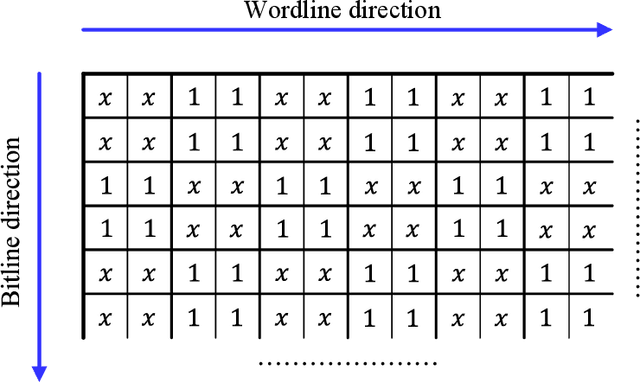
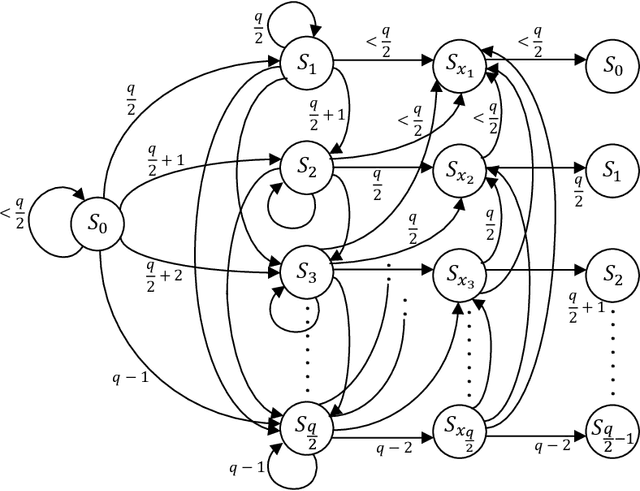
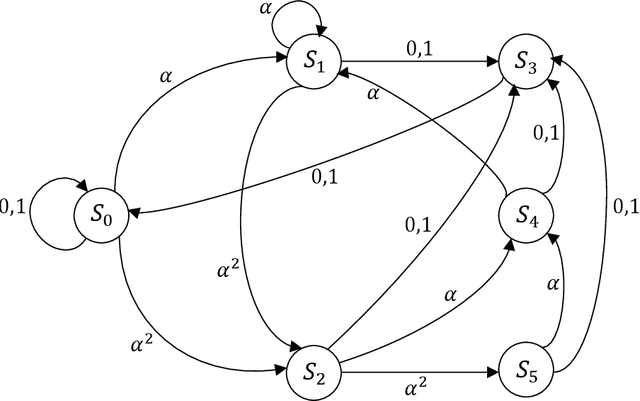
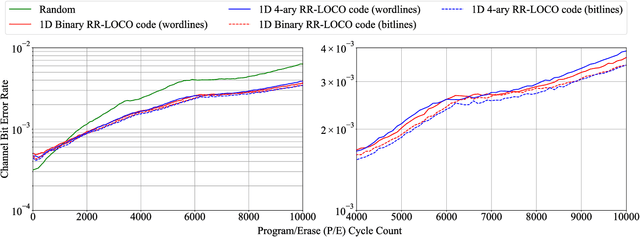
Abstract:The pivotal storage density win achieved by solid-state devices over magnetic devices recently is a result of multiple innovations in physics, architecture, and signal processing. Constrained coding is used in Flash devices to increase reliability via mitigating inter-cell interference. Recently, capacity-achieving constrained codes were introduced to serve that purpose. While these codes result in minimal redundancy, they result in non-negligible complexity increase and access speed limitation since pages cannot be read separately. In this paper, we suggest new constrained coding schemes that have low-complexity and preserve the desirable high access speed in modern Flash devices. The idea is to eliminate error-prone patterns by coding data either only on the left-most page (binary coding) or only on the two left-most pages ($4$-ary coding) while leaving data on all the remaining pages uncoded. Our coding schemes are systematic and capacity-approaching. We refer to the proposed schemes as read-and-run (RR) constrained coding schemes. The $4$-ary RR coding scheme is introduced to limit the rate loss. We analyze the new RR coding schemes and discuss their impact on the probability of occurrence of different charge levels. We also demonstrate the performance improvement achieved via RR coding on a practical triple-level cell Flash device.
Read-and-Run Constrained Coding for Modern Flash Devices
Nov 14, 2021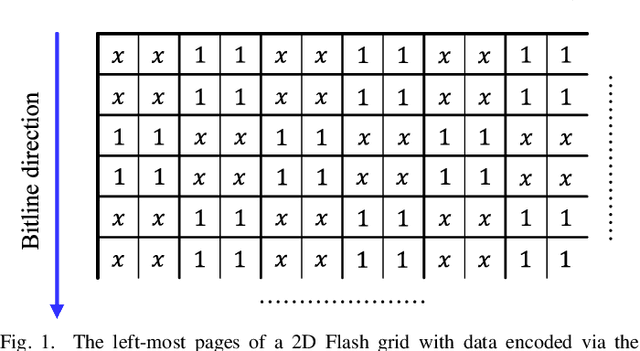
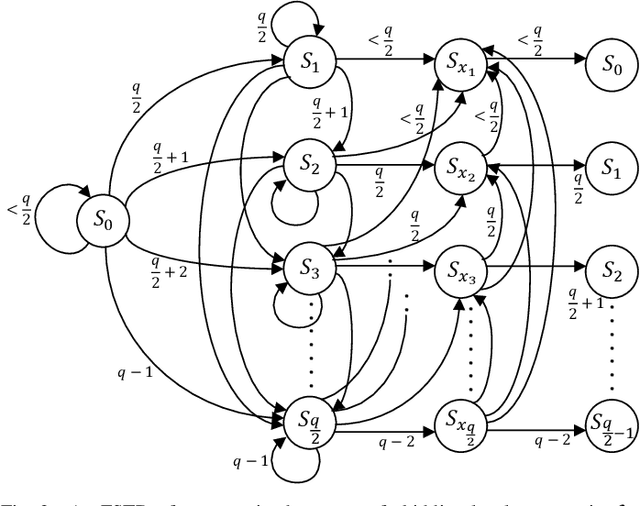
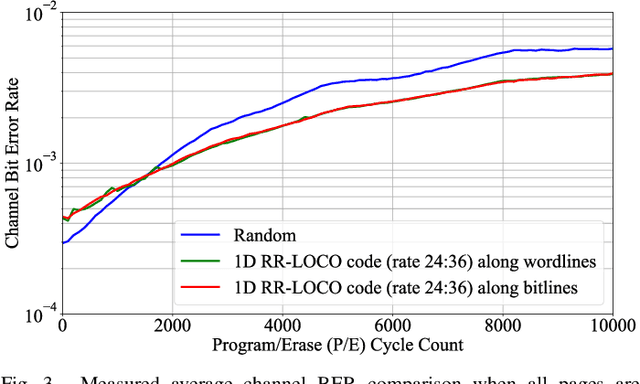
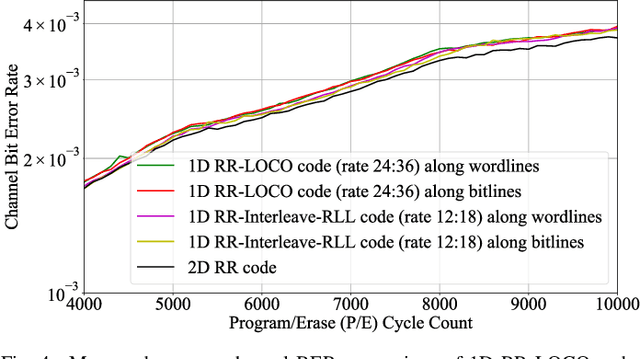
Abstract:The pivotal storage density win achieved by solid-state devices over magnetic devices in 2015 is a result of multiple innovations in physics, architecture, and signal processing. One of the most important innovations in that regard is enabling the storage of more than one bit per cell in the Flash device, i.e., having more than two charge levels per cell. Constrained coding is used in Flash devices to increase reliability via mitigating inter-cell interference that stems from charge propagation among cells. Recently, capacity-achieving constrained codes were introduced to serve that purpose in modern Flash devices, which have more than two levels per cell. While these codes result in minimal redundancy via exploiting the underlying physics, they result in non-negligible complexity increase and access speed limitation since pages cannot be read separately. In this paper, we suggest new constrained coding schemes that have low-complexity and preserve the desirable high access speed in modern Flash devices. The idea is to eliminate error-prone patterns by coding data only on the left-most page while leaving data on all the remaining pages uncoded. Our coding schemes work for any number of levels per cell, offer systematic encoding and decoding, and are capacity-approaching. Since the proposed schemes enable the separation of pages, we refer to them as read-and-run (RR) constrained coding schemes as opposed to schemes adopting read-and-wait for other pages. We analyze the new RR coding schemes and discuss their impact on the probability of occurrence of different charge levels. We also demonstrate the performance improvement achieved via RR coding on a practical triple-level cell Flash device.
Unequal Error Protection Achieves Threshold Gains on BEC and BSC via Higher Fidelity Messages
Jan 22, 2021
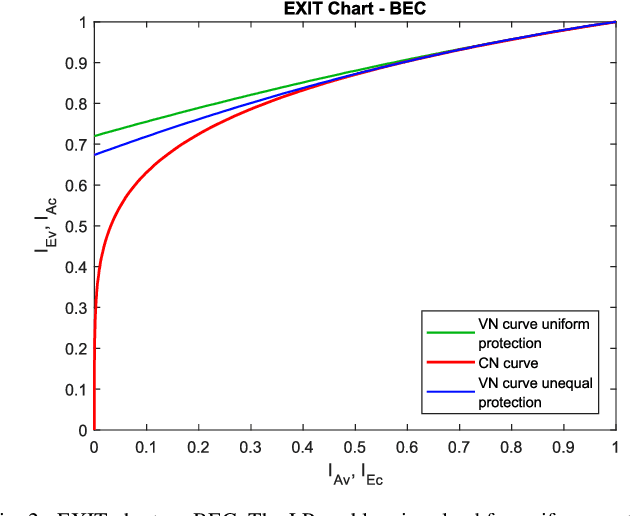
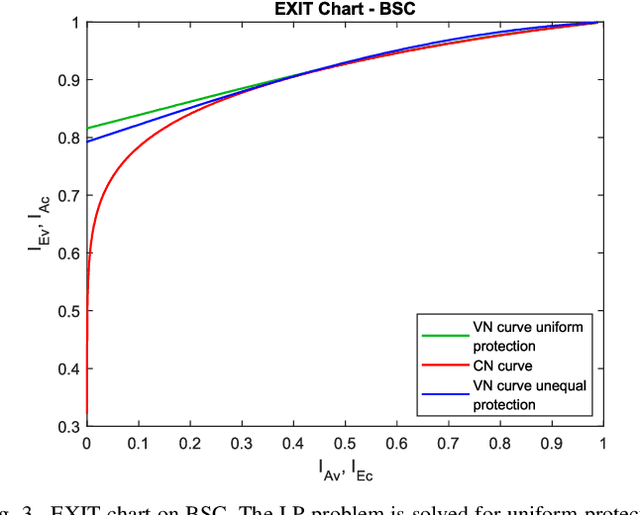

Abstract:Because of their capacity-approaching performance, graph-based codes have a wide range of applications, including communications and storage. In these codes, unequal error protection (UEP) can offer performance gains with limited rate loss. Recent empirical results in magnetic recording (MR) systems show that extra protection for the parity bits of a low-density parity-check (LDPC) code via constrained coding results in significant density gains. In particular, when UEP is applied via more reliable parity bits, higher fidelity messages of parity bits are spread to all bits by message passing algorithm, enabling performance gains. Threshold analysis is a tool to measure the effectiveness of a graph-based code or coding scheme. In this paper, we provide a theoretical analysis of this UEP idea using extrinsic information transfer (EXIT) charts in the binary erasure channel (BEC) and the binary symmetric channel (BSC). We use EXIT functions to investigate the effect of change in mutual information of parity bits on the overall coding scheme. We propose a setup in which parity bits of a repeat-accumulate (RA) LDPC code have lower erasure or crossover probabilities than input information bits. We derive the a-priori and extrinsic mutual information functions for check nodes and variable nodes of the code. After applying our UEP setup to the information functions, we formulate a linear programming problem to find the optimal degree distribution that maximizes the code rate under the decoding convergence constraint. Results show that UEP via higher fidelity parity bits achieves up to about $17\%$ and $28\%$ threshold gains on BEC and BSC, respectively.
 Add to Chrome
Add to Chrome Add to Firefox
Add to Firefox Add to Edge
Add to Edge